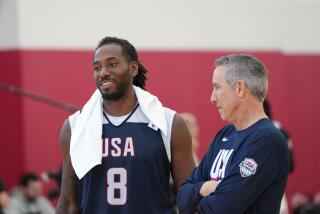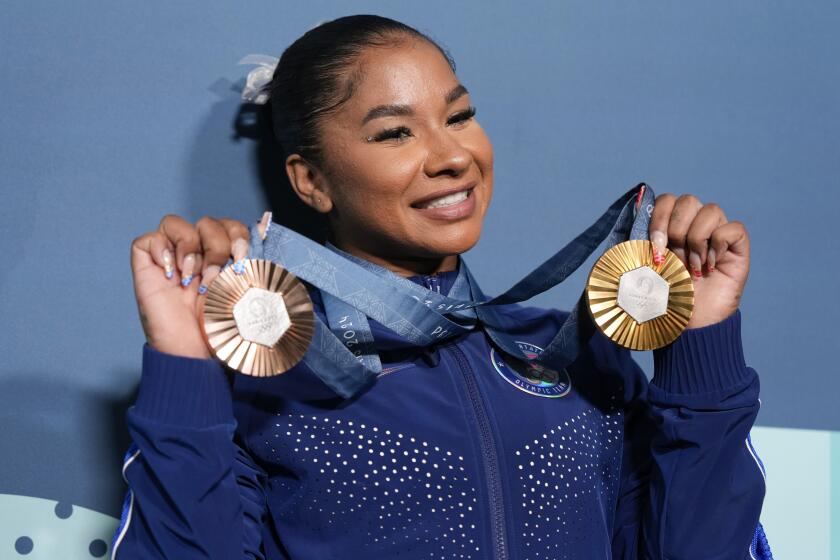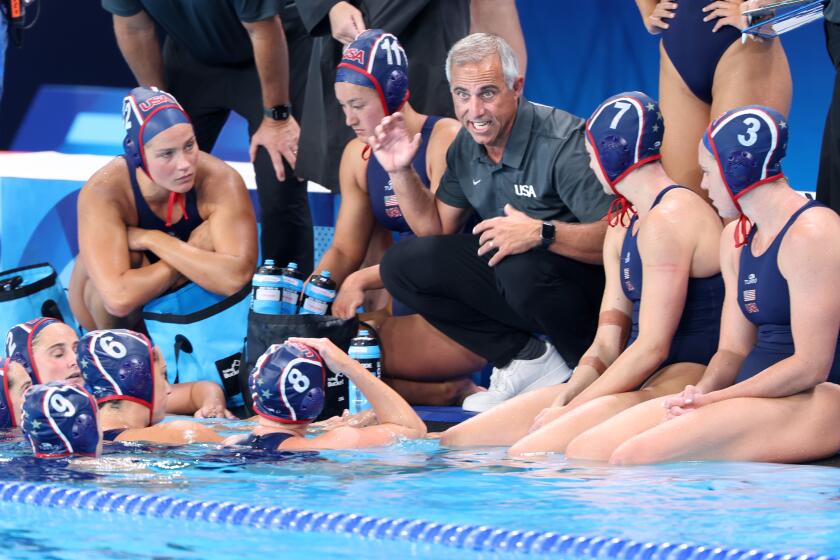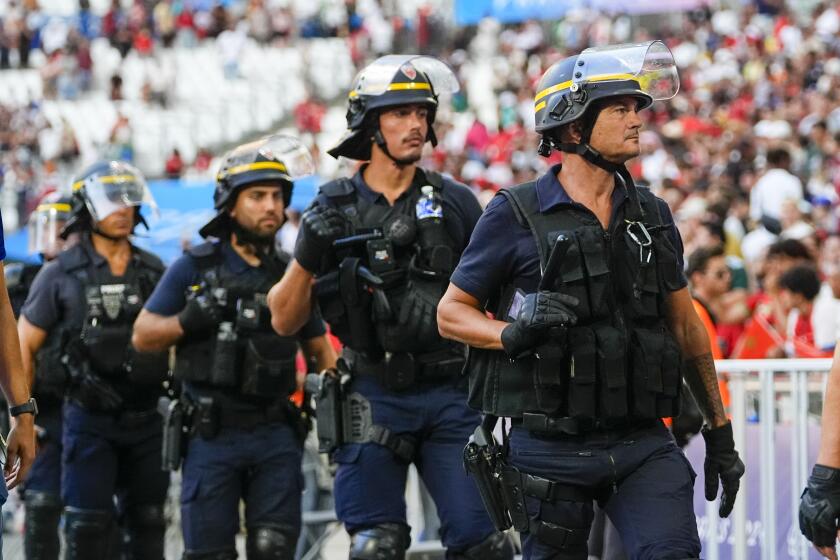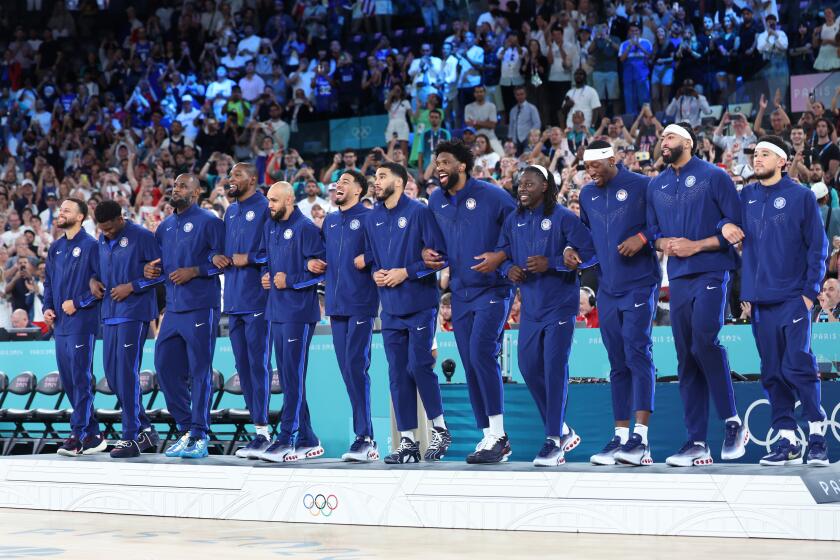Gymnastics’ jolly ranchers
WAVERLY, Texas -- About 20 gymnasts arrive at a secluded ranch where they are enthusiastically greeted by three dogs as well as a bearhug from Bela Karolyi.
The girls and their coaches are then guided toward a metal building filled with chalk dust and vaults, tumbling mats and the welcoming presence of Karolyi’s wife, Martha.
Everyone is smiling, exchanging cheek kisses and information until practice starts. Then Bela disappears.
Martha speaks in a whisper, but she is clearly in charge. That Yurchenko double-twist vault landing? The judges want to see both feet hit the ground without a hop.
That double-twisting layout front-tumbling pass on the floor exercise? Get those toes pointed.
This is the USA Gymnastics national training camp, every month for female gymnasts and their individual coaches. Olympic hopefuls come here, an hour north of Houston, to perform their routines and be critiqued by Martha, the national team coordinator.
“It’s the best system we’ve ever had,” said veteran coach Kelli Hill, who has mentored past Olympians such as Dominique Dawes and Elise Ray. “And I still can’t believe I’m saying this.”
As USA Gymnastics’ national championships begin Wednesday in San Jose, Martha Karolyi said, “our pool of talented girls has never been deeper.”
From these championships the 2007 USA world championships team will be chosen that will compete Sept. 1-9 in Stuttgart, Germany.
Shawn Johnson, a 15-year-old from Des Moines who recently won the Pan American Games all-around gold medal; two-time defending national all-around champion Nastia Liukin, 17, from Parker, Texas; 2006 world championships all-around silver medalist Jana Bieger, 17, of Coconut Creek, Fla.; and 2005 world championships all-around gold medalist Chellsie Memmel, 19, of West Allis, Wis., are all expected to challenge for the national all-around title. So are newcomers such as 14-year-old Ivana Hong and 16-year-old Samantha Peszek, who made the U.S. gold-medal-winning Pan Am Games team this summer.
Coaches around the country say the national training center is a key reason why the U.S. won a team silver medal in Athens three years ago and produced Olympic all-around champion Carly Patterson.
But when the center was started six months before the 2000 Olympics it was fraught with problems. One U.S. coach called it “Communism come to America.”
After a dismal sixth-place team performance at the 1999 world championships, and in a panic about the upcoming Olympics in Sydney, USA Gymnastics officials decreed that every elite female gymnast and her coach attend training camps at Karolyi’s ranch.
The reaction of individual coaches was immediately negative. They resented taking time away from their own gyms, they resented spending weekends sleeping in bunk beds away from Internet access and cellphone reception, and they didn’t like feeling that they were neglecting their other gymnasts. But most of all they chafed under Bela Karolyi’s dictates.
By the time the 2000 Olympic team was chosen, the tensions were obvious. And the Olympic tally was awful. After being the stars of the 1996 Atlanta Games and winning a first-ever team gold medal, the U.S. women left Athens with no medals and plenty of acrimony.
Several of the gymnasts described their Olympic experience as “awful” and “depressing,” and when coaches gathered a month later to map out a plan, Hill said, “We were ready to vote for anything but Bela.”
Except Bela didn’t speak at the meeting. Martha did. She offered the ranch as a central meeting place. She spoke passionately about the need for all national team candidates to train together and learn from each other. She said that Bela would not be in charge, she would be in charge.
“We were, frankly, exhausted,” said Mary Lee Tracy, who coached 1996 Olympian Amanda Borden and 2000 Olympian Alyssa Beckerman. “And the only consensus we had was that we wanted a woman in charge of the national program. Martha was a woman. Pretty much that was all she needed.”
“It was uneasy at first,” said Steve Rybacki, who coached Jamie Dantzscher, who was outspoken in her unhappiness with her Olympic experience.
“It just wasn’t fair,” Dantzscher had said after the 2000 team competition. “Everything I’ve done to get here and it didn’t matter. Bela didn’t know how to treat me as a person.”
But Rybacki said that everybody learned from the 2000 mess. “Martha truly is in charge now,” Rybacki said. “It is a collegial atmosphere.”
And even Bela seems OK with it.
“Even before 2000 I didn’t want to do this,” he said recently. “But we had the ranch here and Martha had the desire. So I wanted this for her and now, I think, everyone is happy.”
Hill said that if someone had told her after the 2000 Olympics that she would still be bringing her top gymnasts to the Karolyi ranch seven years later, “I would have said, ‘No way.’ But here we are and thanks to Martha and compromise we have a system that, I firmly believe, is the best in the world.”
The gymnasts seem to agree. “We learn from each other,” defending national champion Liukin said. “It’s kind of nice to see what everybody else is doing. Plus, Martha can pick out the little things you need to work on.”
Martha is the international expert who interprets what judges are expecting in the way of start values and routine difficulty. She will gently suggest that a girl work more on pointing her toes or nudge another into being more physical.
Besides the 2004 successes, the system has also produced a world championships team gold medal in 2003 and silvers in 2005 and 2006, plus 12 individual world championships medals since 2003.
“And we have so many girls to pick from right now,” Hill said. “I have to say, and I can’t believe I’m saying it, but this system works.”
--
--
(BEGIN TEXT OF INFOBOX)
There’s something about Mary Lou ...
Since Mary Lou Retton became the first U.S. woman to win an Olympic all-around gymnastics gold medal, the sport has been endlessly on the lookout for the ‘next Mary Lou.’ It isn’t enough to win an Olympic or world championships gold medal, though. The ‘next Mary Lou’ needs an indefinable pizazz and a personality that captures the eyes of advertisers. Although Shawn Johnson and Nastia Liukin are the latest potential stars, the past hopefuls turned out to be wannabes and coulda beens:
Shawn Johnson: In her first year at the senior level, the 15-year-old recently won four gold medals at the Pan American Games, including the all-around, and her strong tumbling has earned Martha Karolyi’s praise.
Nastia Liukin: Liukin missed the age cutoff for the 2004 team by a few months. Now 17, she is the two-time defending U.S. nationals all-around champion, but she didn’t compete in the all-around at the Pan Am Games because of an injury and is being pushed by the newest crop of younger gymnasts led by Johnson.
Kim Zmeskal: Leading up to the 1992 Barcelona Olympics, Zmeskal won three consecutive U.S. all-around championships, and in 1991 became the first U.S. man or woman to win an all-around gold medal at the world championships. Though she was a heavy favorite to win the 1992 Olympic all-around gold, Zmeskal fell off the balance beam on her first routine and left with only the team bronze medal.
Shannon Miller: Expected to be a bit player on the 1992 team, Miller took home five medals, including a silver in the all-around. In Atlanta in 1996, she won team and balance beam gold medals. But Miller found speaking in public painful and she was overshadowed in 1996 by Kerri Strug’s memorable vault on an injured ankle.
Vanessa Atler: After being too young by six weeks to make the 1996 team, Atler was groomed for 2000 after she shared the 1997 national all-around title with Kristy Powell. Atler had crowd-pleasing skills and a winning smile, but she began having trouble staying on the uneven bars in 1998 and by the 2000 Olympic trials she couldn’t complete a single clean routine and didn’t make the team.
Dominique Dawes: One of few African American elite female gymnasts, she made three U.S. Olympic teams -- 1992, 1996 and 2000 -- but never had a breakout individual moment. She led the 1996 Olympic all-around competition after two events until she fell on a tumbling pass.
Dominique Moceanu: In 1995, two months before her 14th birthday, Moceanu became the youngest U.S. all-around champion ever and an immediate favorite for the 1996 Olympic all-around gold. She also had an award-winning smile and was fearless in front of cameras. But Moceanu had to miss the 1996 Olympic trials because of a stress fracture in her right leg. She was put on the team and earned a team gold medal, but she didn’t win any individual medals. Moceanu made unsuccessful attempts to qualify for the 2000 and 2004 teams.
Carly Patterson: In Athens, she became the first American woman since Retton to win the Olympic all-around gold medal and she added a team silver medal and a vault silver medal. But despite being dubbed “the next Mary Lou” almost from the moment the gold medal was put around her neck, Patterson’s serious competition face and subdued personality -- as well as her decision to retire from gymnastics -- kept her anonymous in the marketing world.
-- Diane Pucin
More to Read
Go beyond the scoreboard
Get the latest on L.A.'s teams in the daily Sports Report newsletter.
You may occasionally receive promotional content from the Los Angeles Times.

